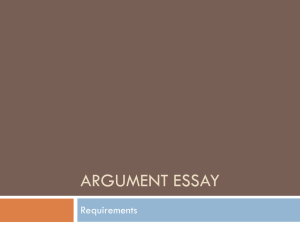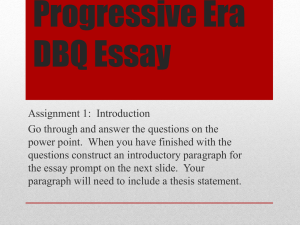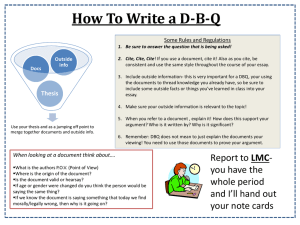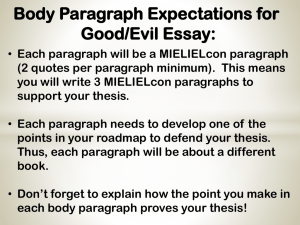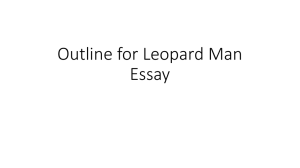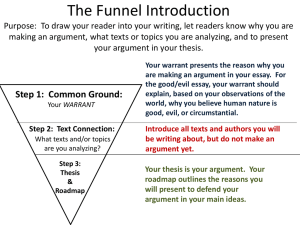Writing a DBQ essay - Von Steuben Metropolitan Science Center
advertisement
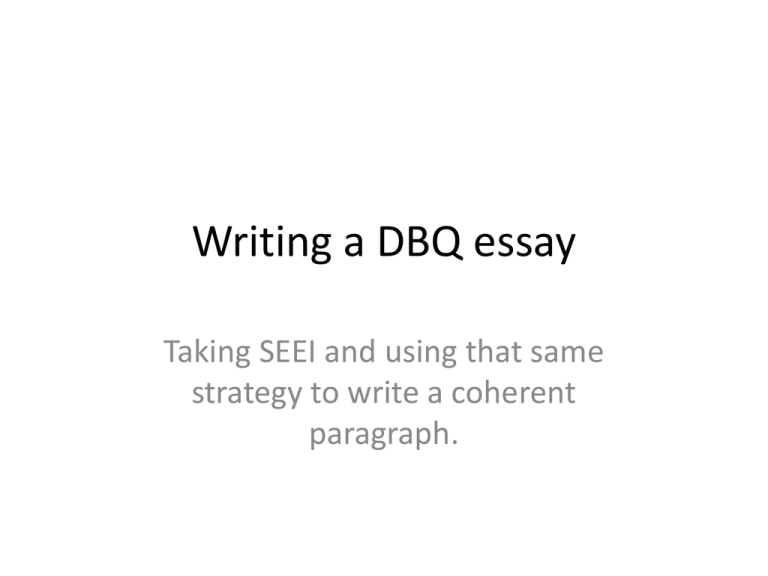
Writing a DBQ essay
Taking SEEI and using that same
strategy to write a coherent
paragraph.
SEEI Method
• S – State or Define (word, topic, claim or
concept)
• E – Elaborate or Clarify (expound on the
concept, provide clearer background info)
• E – Exemplify (give a concrete example from
the text or real life)
• I – Illustrate (provide an analogy or metaphor
to clarify your position and connect to the
claim)
SEEI in paragraph form
S – Make your specific claim (one per paragraph)
E – Elaborate (provide background on this one
claim) Who? What? When? Where?
E – Exemplify (provide a concrete example to
support this one claim)
I – Illustrate (breakdown the example and
connect it back to the claim of the paragraph)
T – Transition (lead from one claim to the next)
Organizing Your ideas
• An important step when answering a DBQ
question or writing an essay is to organize
your evidence into analytical categories or
“buckets.”
• The “buckets” can help you link up common
pieces of evidence and help you identify when
they may be used appropriately.
P-E-R-S-I-A
• A commonly used bucketing tool is the
acronym PERSIA.
• P – Politics (references to government,
political leaders, war, law/rules)
• E – Economics (money/wealth, resources,
trade)
• R – Religion (Beliefs, Religious institutions,
Religious practices, god(s), etc.)
• S – Social Issues (Crime, interaction between
races, issues of sexuality, gender relations, age
relations, topics relating to culture)
• I – Ideas/Ideology (Philosophy, Technological
advances, Theories, Issues related to math
and science)
• A – Arts/Architecture (Buildings, sculpture,
paintings, visual representations)
* Assign a category to each of the
documents/topics and then attempt to link
them.
Outlining … setting up your paper
• Once you have successfully bucketed your
documents … the next step is organizing an
outline.
• Remember the focus question:
“How did colonization affect Kenya?”
Setting up your outline
• First: Determine your position on the central
question. Your thesis is your main argument.
• Second: Determine how you will make your
argument. (Roadmap)
“I intend to prove {Argument} by demonstrating
_____(Claim 1)______, ___(Claim 2)___ and
__(Claim 3)__.”
Use your Roadmap to set up your
paper
• Introduction (Thesis & Roadmap)
• Body Paragraph #1 (Focus on Claim 1)
{Include relevant evidence from documents}
• Body Paragraph #2 (Focus on Claim 2)
{Include relevant evidence from documents}
• Body Paragraph #3 (Focus on Claim 3)
{Include relevant evidence from documents}
• Conclusion (Restatement of thesis and
roadmap)
Citing the source
• Citations: Phrases taken directly from the
source (document).
• Must use quotation marks “ “
Example: “many Africans saw colonization in
Africa as a progressive and civilizing force …”
(Doc F).
* Remember to then explain the meaning of the
quote and how it relates to your claim.
Making the transition
• Transitions sentences: Come at the beginning and
end of each paragraph. These are extremely
important for bridging one idea to the next.
• Remember: Your argument needs to make logical
sense … it is YOUR job … NOT THE READER’s job…
to make these connections.
• Example: The Romans not only had a high
tolerance for violence, like Americans, they also
spent a large amount of their resources on
warfare.
Introduction
• Grabber Statement (attempts to grab the
reader’s attention)
• Background Information (Time, place,
participants)
• Background Information (Time, place,
participants)
• Thesis statement (your main argument)
• Roadmap (guide for your essay)
Conclusion
• Restatement of thesis (should not be word for
word)
• Address how you have proven your case (draw on
the roadmap)
• Address any unique points you discussed
• Explanation of why the question is important
today (what will happen if the issue is not
addressed?)
• Final statement (why this particular issue is
important)
